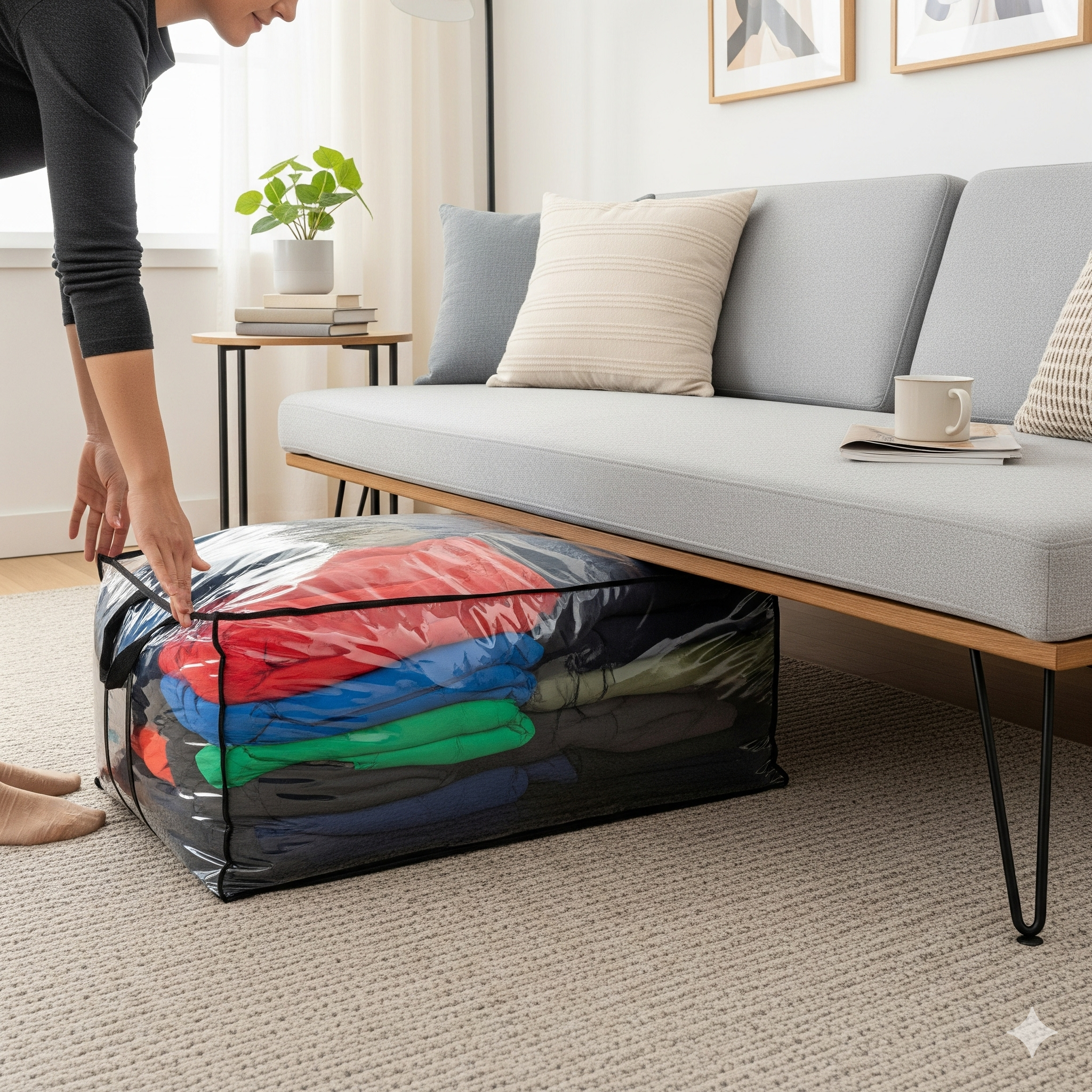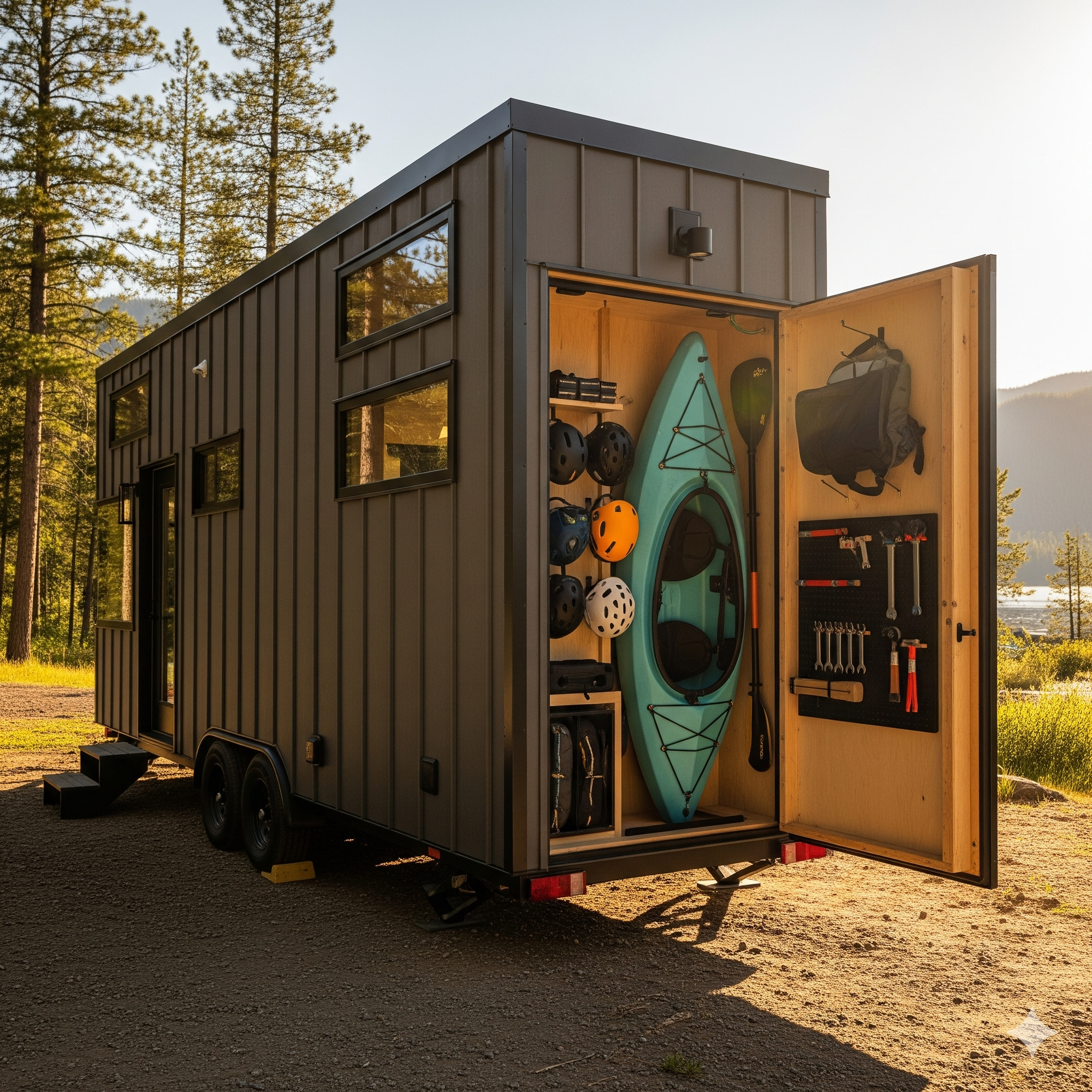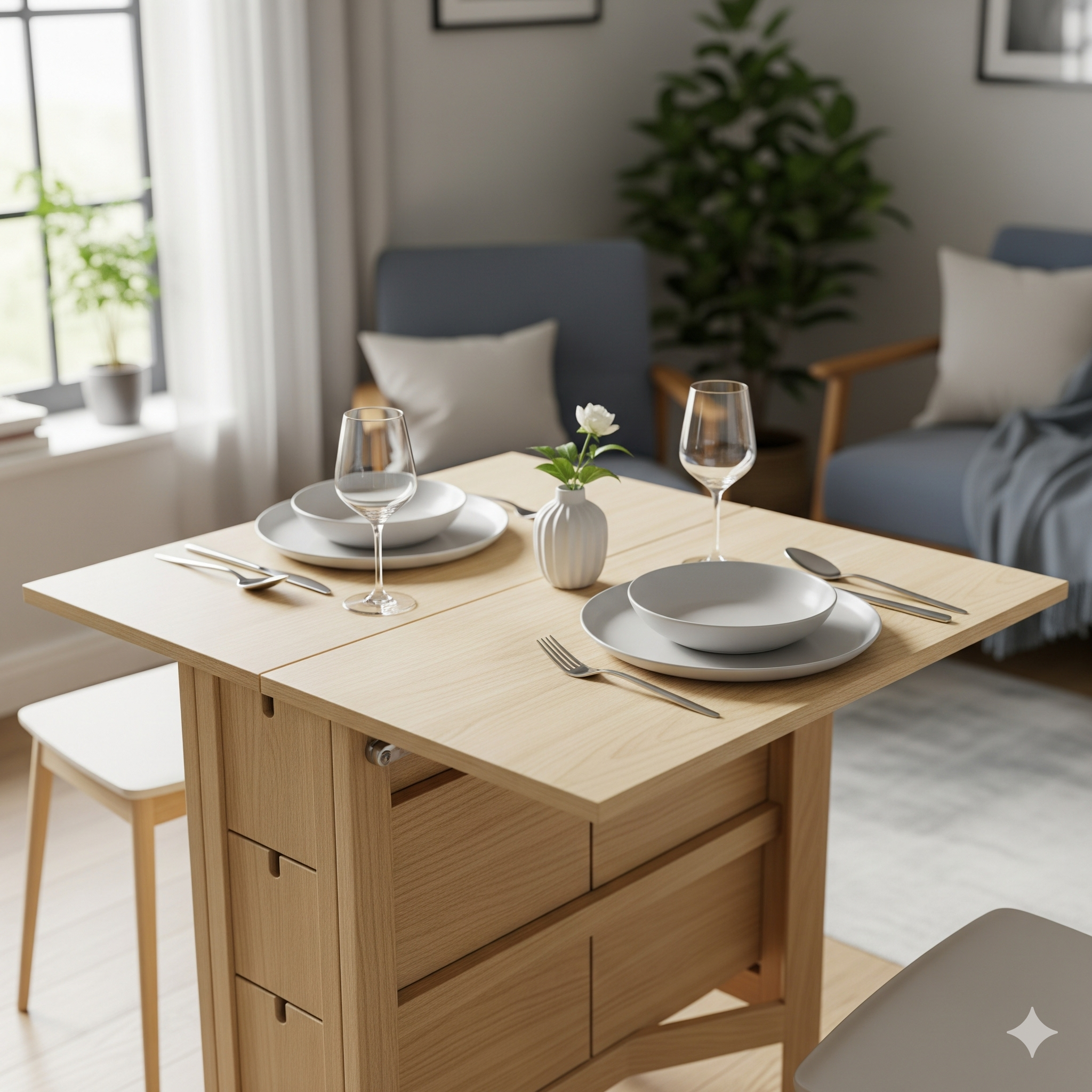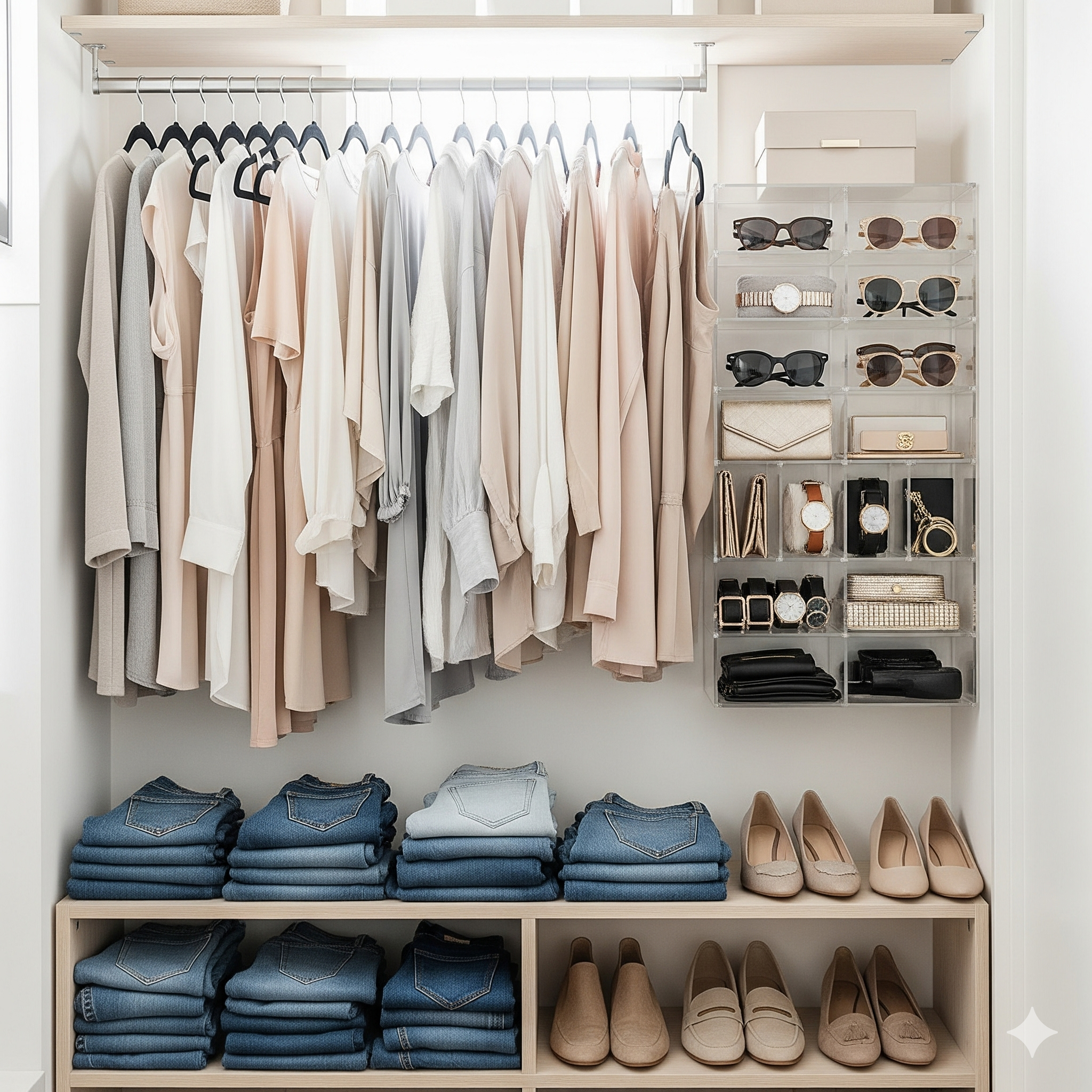Where to Store Luggage in a Small Apartment
Discover where to store luggage in a small apartment and other bulky items like winter clothes. Our guide covers vacuum bags, hidden spots, and more.
Conquering the Clutter Giants: How to Store Luggage, Winter Coats, and Other Bulky Items in a Small Home
There’s a special kind of frustration that comes with small-space living. You can have the most beautifully organized bookshelves and a perfectly tidy kitchen, but then you turn around and see it: the clutter giant. It might be a suitcase from your last trip loitering in the corner, a giant box of holiday decorations, or a puffy winter coat that has no home in July. As a tiny home dweller and the voice of Neat Tiny Home, I know this frustration intimately. Bulky, occasional-use items are the final boss of organization. They don’t fit in drawers, they eat up precious closet space, and they can make an otherwise tidy home feel cluttered and cramped. One of the most common questions I get is, without a doubt, where to store luggage in a small apartment, and it’s a question that opens up a much larger conversation about all of our bulky belongings.
This is my ultimate guide to conquering those clutter giants. We are going on a deep dive to find every hidden nook and clever cranny in your home. We’ll start by tackling the most notorious space-hog: luggage. I’ll share all my secrets on where to store luggage in a small apartment so it practically disappears. Then, we’ll move on to other seasonal behemoths, with a special focus on the art of storing winter clothes using transformative tools like vacuum storage bags. We’ll explore multi-functional furniture, vertical space, and the mindset you need to adopt to win the war against bulky clutter. My promise is to give you a complete arsenal of strategies so you can reclaim your space and make your small home feel spacious, serene, and truly organized, once and for all.
The Bulky Item Dilemma: Reclaiming Your Space from Seasonal and Occasional-Use Clutter
Before we can find a home for these large items, we have to honestly evaluate if they deserve a spot in our home at all. The very nature of bulky items is that they take up a disproportionate amount of space relative to how often we use them. A large suitcase might take up 20% of your closet but get used only 1% of the year. This is a terrible return on investment for your precious square footage. Therefore, the first step is always a thoughtful audit. This isn’t just about finding clever hiding spots; it’s about making conscious decisions and reducing the sheer volume of “stuff” that needs to be hidden in the first place. This mindset is the foundation for successfully storing bulky items and is even more critical than finding the perfect spot where to store luggage in a small apartment.
The Psychology of “Just in Case” Items and How They Steal Space
Our homes are filled with “just in case” items. The extra-large cooler for a hypothetical beach party, the massive stockpot for a soup you make once every three years, the guest bedding for visitors you rarely have. We hold onto these things out of a fear of future need. The problem is, this “just in case” mentality forces us to live in a home built for a hypothetical future instead of our actual present. Acknowledging this is key. Every bulky item you keep “just in case” is actively stealing space from your daily life. The goal is to find a balance, keeping the truly essential bulky items and letting go of the ones that are merely cluttering your present for a low-probability future. This mental shift is liberating and the true first step to a decluttered home.
The Golden Rule: Can It Be Rented, Borrowed, or Digitized?
For every bulky item you’re on the fence about, ask yourself this golden question. Do you need to own a carpet cleaner that you use once a year, or can you rent one from the grocery store for a few dollars? Do you and your neighbor both need to own a massive ladder, or can you agree to share one? Do you need to keep boxes of old documents, or can they be scanned and digitized? In today’s sharing economy, access is often better than ownership. For things like specialized tools, party supplies, or sporting equipment you use infrequently, look into local rental options or borrowing from friends. This is a core tenet of minimalist living and drastically reduces the number of “clutter giants” you need to find a home for.
Solving the Luggage Problem: Where to Store Luggage in a Small Apartment
Alright, let’s tackle the number one offender: luggage. Suitcases are awkwardly shaped, rigid, and by design, mostly empty space when not in use. They are the bane of a small apartment dweller’s existence. The question of where to store luggage in a small apartment is so common because the solutions aren’t always obvious. A closet is the default, but it’s often the worst choice, as the suitcase eats up room that could be used for daily essentials like clothes and shoes. The key is to find “dead space”—areas in your home that are hard to use for anything else. With a little creativity, you can make your luggage practically vanish.
Under the Bed: The Prime Real Estate for Suitcases
If you have even a few inches of clearance under your bed, you have a potential home for your luggage. This is my absolute favorite spot. It’s out of sight, out of mind, and utilizes a huge, often-wasted area. Hardshell suitcases can often slide right under. For soft-sided duffel bags, this is a perfect spot. If your bed frame is too low, consider investing in a set of bed risers. For just a few dollars, you can lift your bed by 3-6 inches, creating a cavern of storage space. This is often the simplest and most effective answer to the question of where to store luggage in a small apartment. Just be sure to give the suitcase a quick wipe-down before storing to avoid bringing dirt into your sleeping area.
Inside Other Luggage: The “Nesting Doll” Technique
This is a simple but brilliant hack. If you have multiple suitcases, don’t store them side-by-side. Store them inside one another, like Russian nesting dolls. Your carry-on goes inside your medium-sized suitcase, which then goes inside your largest one. This reduces the storage footprint of three or four bags down to just one. But don’t stop there! The innermost suitcase is still a valuable container. Use it to store other occasional-use items like off-season clothing (we’ll get to that!), extra bedding, or even sentimental items. This technique maximizes efficiency by ensuring no space—not even the space inside your luggage—goes to waste.
| Luggage Storage Location | Pros | Cons | Best For |
|---|---|---|---|
| Under the Bed | Completely hidden; uses dead space. | Requires enough clearance; can get dusty. | Hardshell suitcases, duffel bags. |
| Top of Closet/Cabinets | Utilizes high vertical space. | Can be difficult to access; needs to look tidy. | Soft-sided bags, smaller carry-ons. |
| As Furniture (e.g., Trunk) | Multi-functional; adds character. | Only works for aesthetic pieces; daily access is tricky. | Vintage trunks, attractive hard-sided cases. |
Hidden in Plain Sight: Using Vintage Trunks as Furniture
Sometimes the best hiding place is no hiding place at all. A beautiful vintage steamer trunk or a handsome hard-sided suitcase can double as a piece of furniture. I’ve used a flat-topped trunk as a coffee table for years. It adds a ton of character to the room and provides a massive amount of hidden storage inside—perfect for extra blankets or board games. A smaller, stylish suitcase can be used as a unique side table or nightstand. This approach turns a storage problem into a design statement, a perfect example of the multi-functional mindset required for small-space living.
Mastering Seasonal Storage: The Art of Storing Winter Clothes
After luggage, the next great space-hog is seasonal clothing. That collection of puffy coats, chunky sweaters, and thermal leggings is essential for cold weather, but in the warmer months, it’s nothing but bulky clutter. Properly storing winter clothes is a seasonal ritual that can free up an incredible amount of space in your main closet, making your daily wardrobe feel spacious and manageable. The key is compression and protection. You want to make your items as small as possible while keeping them safe from dust, moisture, and pests until you need them again.
The Power of Compression: Why Vacuum Storage Bags are a Game-Changer
If you learn one thing about storing winter clothes, let it be this: vacuum storage bags are your best friend. These are heavy-duty plastic bags with a special valve that allows you to suck all the air out with a standard vacuum cleaner. The results are astounding. A giant pile of puffy coats and sweaters can be compressed into a slim, dense, and solid brick that takes up 75% less space. It’s an incredibly satisfying process. I use brands like SpaceSaver, and they are perfect for maximizing the space under your bed or on the top shelf of your closet. They also keep your clothes completely sealed and protected from the elements. This is, without a doubt, the most effective tool for this job.
Proper Cleaning and Prep Before You Pack
Before you seal anything away for several months, it’s critical to clean it properly. Moths and other pests are attracted to dirt, sweat, and food particles. Storing dirty clothes can lead to permanent stains and insect damage. Wash or dry-clean everything according to its care label. Make sure every single item is bone dry before it goes into a bag or bin, as even a little moisture can lead to mildew. It’s also a good idea to empty all pockets—you’ll thank yourself later when you’re not missing that chapstick or glove. This prep work ensures your clothes will emerge from storage fresh and ready to wear.
Creative Storage Solutions for Other Awkward and Bulky Items
Of course, our clutter giants aren’t limited to luggage and clothing. Every home has its own unique collection of awkward items, from sports equipment to holiday decorations. The principles remain the same: look for dead space, think vertically, and use containers to create order. A successful strategy for bulky items requires a custom approach, analyzing each item’s shape, size, and frequency of use to find its perfect, out-of-the-way home. Let’s tackle a few more common culprits.
Sports Equipment and Holiday Decorations
For items like yoga mats, skis, or skateboards, the wall is your answer. A simple set of wall-mounted hooks or a specialized rack can turn your gear into a piece of functional art and, most importantly, get it off the floor. For holiday decorations, my rule is uniform containment. Invest in a set of sturdy, matching bins (I prefer opaque ones to reduce visual clutter). Consolidating all your decorations into a few clearly labeled, stackable bins makes them much easier to store. These bins can then be placed on the highest shelf of a closet, in a storage ottoman, or, if you’re lucky enough to have one, a small external storage space.
Extra Bedding and Large Kitchen Appliances
Extra duvets, pillows, and guest linens are notoriously bulky. This is another perfect job for vacuum storage bags! A compressed duvet can easily slide under a sofa or bed. Alternatively, a storage bed or a large storage ottoman is the ideal home for these items. For the kitchen, that stand mixer or bread maker you only use a few times a year shouldn’t live on your precious counter space. Designate a spot for these “less-frequent use” appliances on a high shelf in a kitchen cabinet or even on the top shelf of your pantry or another closet. Getting them out of your daily workspace makes a huge difference in how functional your kitchen feels.
By applying these targeted strategies, from finding the perfect spot where to store luggage in a small apartment to mastering the art of the seasonal swap, you can systematically eliminate the bulky-item clutter from your life. Your home will feel bigger, calmer, and more functional, freeing you up to enjoy the space you have.
What’s your biggest “clutter giant” at home? Have you discovered a clever storage spot that I didn’t mention? Share your challenges and successes in the comments below!
Frequently Asked Questions (FAQ)
Is it bad for clothes to be in vacuum-sealed bags for a long time?
For most durable items like coats, sweaters, and jeans, it’s perfectly fine for 6-8 months. However, for very delicate natural fibers like high-end cashmere or down-filled items, over-compressing can crush the fibers and reduce their loft over time. For these delicate items, you can use the bags but suck out just enough air to make them compact, not rock-solid. Or, opt for a breathable under-bed bin instead.
I don’t have any space under my bed. What’s the next best spot for luggage?
If under the bed is not an option, the next best place is high up. Look at the top shelf of your closet, bedroom closet, or even the space above your kitchen cabinets. A suitcase can be laid flat in these spaces. Another great spot is behind other furniture. A slim suitcase can often slide behind a sofa or an armchair, completely hidden from view.
Is it worth it to rent a storage unit for my bulky items?
In my opinion, for most people living a minimalist or small-space lifestyle, a storage unit should be a last resort and only for a short-term transition. A storage unit can easily become a place where you pay to store things you’ve forgotten you own. The monthly cost adds up, and it often enables us to hold onto clutter we should have dealt with. The one exception might be for highly specialized, valuable gear (like professional equipment or a full camping setup) that simply cannot fit but is used regularly.





Post Comment